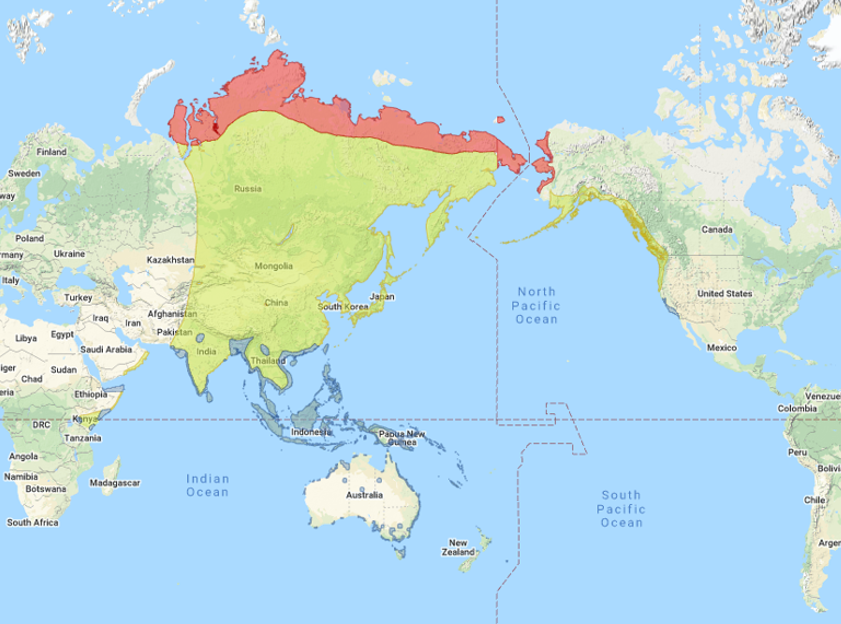Birdfinding.info ⇒ Common from August to April across a large swath of the Asia-Pacific region, including both coasts of India, the Malay Peninsula, the eastern coast of Australia, and many, if not most, islands of the tropical Pacific. During spring and fall migration, it becomes common to abundant on coasts and fields of East Asia. In Hawaii it is generally the commonest shorebird, occurring on beaches, lawns, golf courses, and alpine meadows. Along the Pacific coast of North America it is uncommon but regular, mainly in fall, from Alaska to Baja California.
Pacific Golden-Plover
Pluvialis fulva
Family: Pluvialidae
Breeds on arctic tundra of Siberia and western Alaska. Winters in southern Asia, Australia and islands of the Indian and Pacific Oceans.
Breeding. Breeds from late May to July on well-drained tundra of the Siberian coastal plain from the Yamal Peninsula east to Chukotka and south to the northern Kamchatka Peninsula and the northern coastal plain of the Sea of Okhotsk; and in western Alaska from Point Hope south to Bristol Bay.
Nonbreeding. Winters from October to April in open fields and shoreside habitats of: southern Asia from the Arabian Peninsula to eastern China (to Fujian); throughout Indonesia and Australasia; on Indian Ocean islands including the Seychelles, Maldives, Chagas, Andamans, and Sri Lanka; and on most island groups of the tropical Pacific from Taiwan, the Ryukyus, and the Philippines, east to Hawaii and the Tuamotu Archipelago, and south to New Zealand.
Small numbers regularly winter farther west to East Africa and east to Mexico’s offshore islands and the coasts of California and Baja California. Also rarely north of usual range along temperate coasts north to Honshu and British Columbia, and south to South Africa.
A few stragglers remain in some parts of the winter range year-round, especially in the tropical Pacific.
Movements. Northbound migration occurs mainly during April and May, with most departing from their tropical wintering areas in early April and arriving on the breeding grounds from late May into early June.
Southbound migration is protracted, with departures from the breeding grounds extending from late June into September. Most adults return to tropical Pacific winter quarters in August.
Juveniles wander widely in September and October, especially to the Pacific Coast of North America and northern Europe. Vagrants occur somewhat regularly in all other regions of North America, Central America, and Europe, and irregularly in the West Indies, Macaronesia, and northwestern South America (perhaps also in eastern South America, where it would be difficult to detect because vastly outnumbered by nearly identical American Golden-Plovers).
Identification
Marginally the smallest Pluvialis plover, usually somewhat “golden” (yellowish), and always extremely similar to the closely related American Golden-Plover.

Pacific Golden-Plover, male in typical breeding plumage. (Anini Beach Park, Kauai, Hawaii; March 22, 2018.) © Russ Morgan
Breeding Plumage. As with other Pluvialis plovers, males in full breeding plumage have a regal appearance, with glittering upperparts (dark with yellow and white speckles) and a solid-black face and underparts framed by a broad white border.
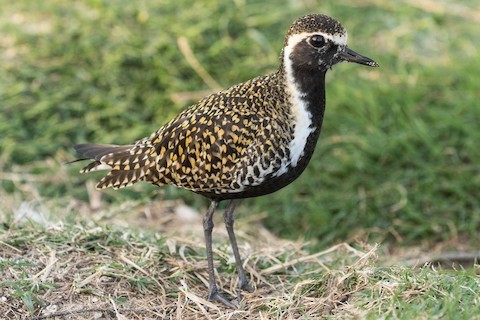
Pacific Golden-Plover, male in typical breeding plumage. (Sand Island, Midway Atoll National Wildlife Refuge, Hawaii; April 9, 2018.) © Eric VanderWerf

Pacific Golden-Plover, male in typical breeding plumage, but showing wide white border beside chest (thus resembling American Golden-Plover). (Aimakapa Pond, Kaloko-Honokohau National Historic Park, Big Island, Hawaii; March 21, 2020.) © Alex Wang
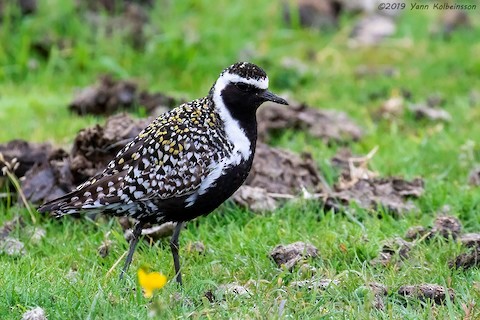
Pacific Golden-Plover, male in breeding plumage with exceptionally white upperparts, and far outside its usual range. (Síki í Garði, Suðurnes, Iceland; July 13, 2019.) © Yann Kolbeinsson

Pacific Golden-Plover, male in breeding plumage with exceptionally golden upperparts. (Kalaloch Creek Estuary, Olympic National Park, Washington; April 30, 2011.) © Warren Lynn
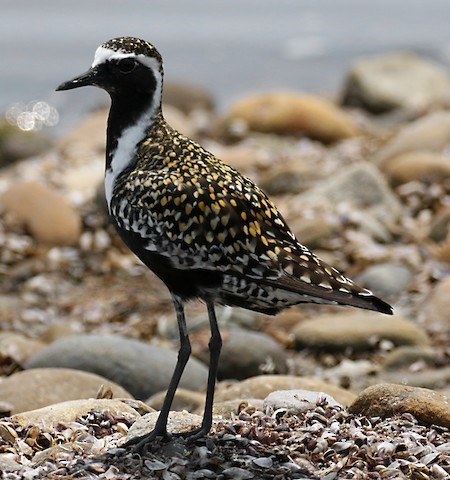
Pacific Golden-Plover, male in typical breeding plumage. (Aogu Wetland, Chiayi County, Taiwan; May 3, 2017.) © Ed Thomas

Pacific Golden-Plover, male in breeding plumage with exceptionally white upperparts. (Koke’e State Park, Kauai, Hawaii; April 5, 2012.) © George Gibbs
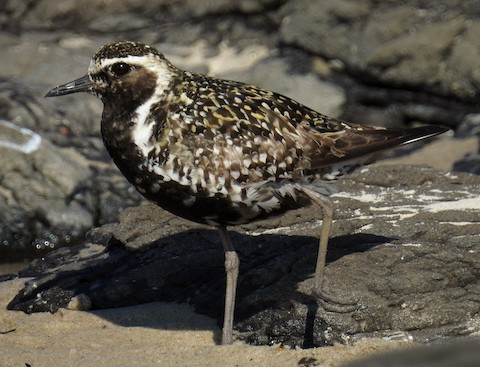
Pacific Golden-Plover, male molting out of breeding plumage. (Flat Rock, Ballina, New South Wales, Australia; September 16, 2017.) © Steven McBride

Pacific Golden-Plover, male in typical breeding plumage, but showing wide white border beside chest (thus resembling American Golden-Plover). (Ko Olina, Oahu, Hawaii; April 18, 2014.) © Ethan Goodman
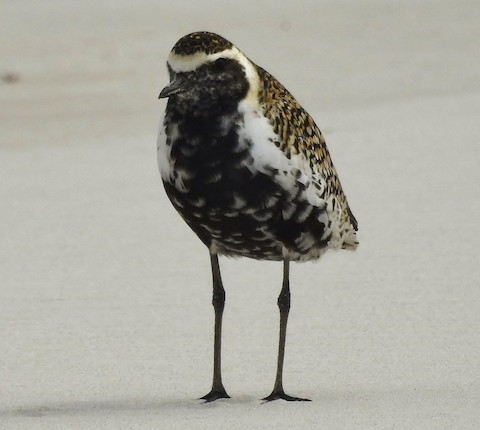
Pacific Golden-Plover, male molting into breeding plumage. (South Ballina Beach, New South Wales, Australia; March 19, 2017.) © Steven McBride

Pacific Golden-Plover, male in breeding plumage with exceptionally golden upperparts. (Kalaloch Creek Estuary, Olympic National Park, Washington; April 30, 2011.) © Warren Lynn
Females in breeding plumage (and molting males) resemble breeding males but with a paler face and underparts—often a blotchy mix of blackish and pale feathers.
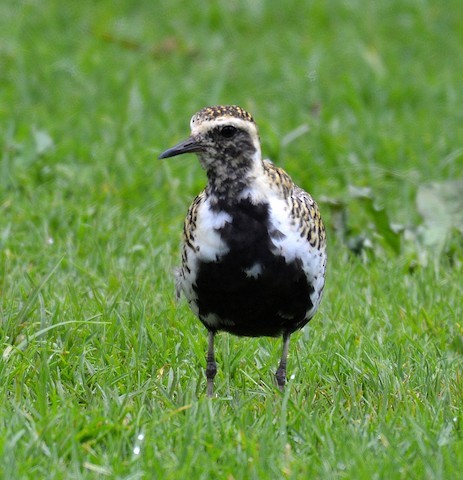
Pacific Golden-Plover, female in breeding plumage—or male molting into breeding plumage. (Koke’e State Park, Kauai, Hawaii; March 29, 2016.) © Dan Murphy
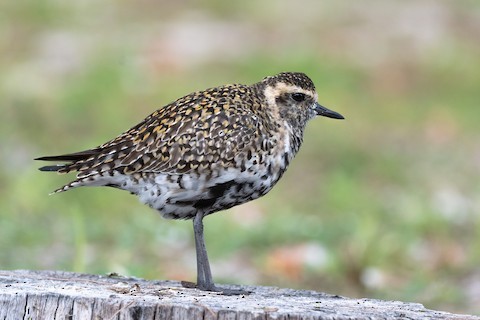
Pacific Golden-Plover, female in breeding plumage—or male molting into breeding plumage. (Lady Elliot Island, Queensland, Australia; March 14, 2020.) © Barry Deacon

Pacific Golden-Plover, female in breeding plumage—or male molting into breeding plumage. (Hokuala Golf Course, Lihue, Kauai, Hawaii; February 29, 2020.) © Donna Pomeroy
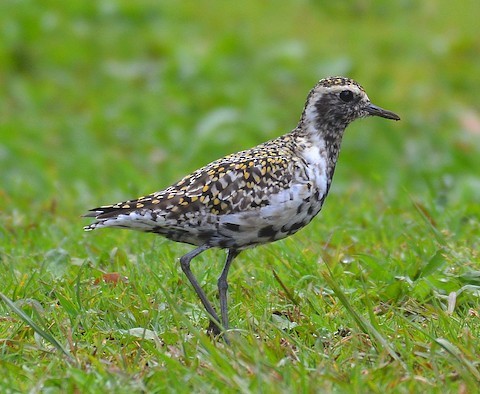
Pacific Golden-Plover, female in breeding plumage—or male molting into breeding plumage. (Koke’e State Park, Kauai, Hawaii; March 29, 2016.) © Dan Murphy

Pacific Golden-Plover, female molting into an exceptionally yellow breeding plumage. (Ka’ena Point, Oahu, Hawaii; April 2, 2017.) © Jason Van
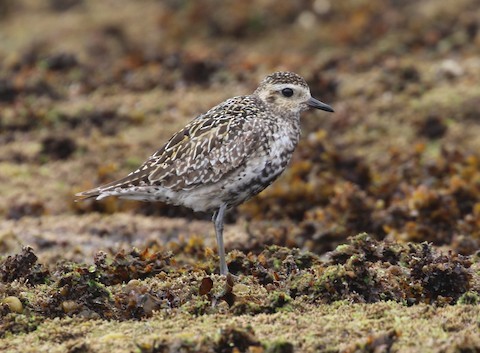
Pacific Golden-Plover, molting out of breeding plumage. (Long Reef Aquatic Reserve, Collaroy, New South Wales, Australia; September 30, 2019.) © Martin Allen
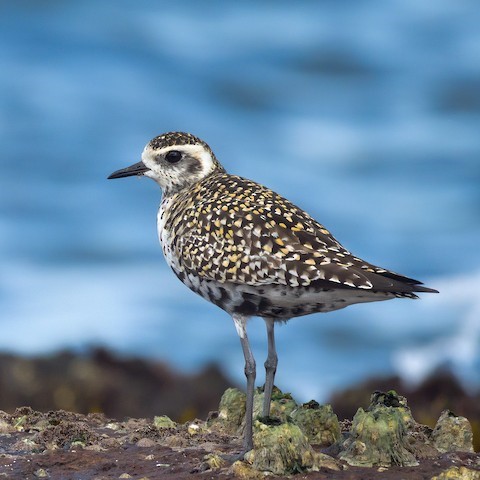
Pacific Golden-Plover, female in breeding plumage—or male molting into breeding plumage. (Kurnell, New South Wales, Australia; March 13, 2021.) © Matthew Egan
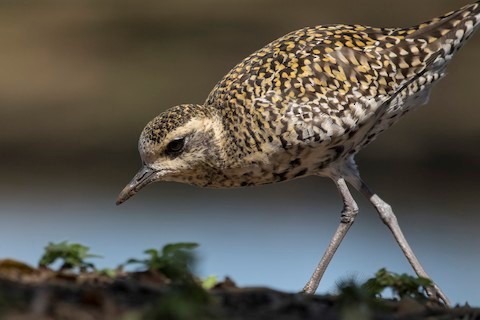
Pacific Golden-Plover, molting into breeding plumage. (Waiakea Pond, Wailoa River State Park, Big Island, Hawaii; February 26, 2019.) © Jacob Drucker

Pacific Golden-Plover, molting into breeding plumage. (Clontarf, Queensland, Australia; March 20, 2021.) © Owen Lawton
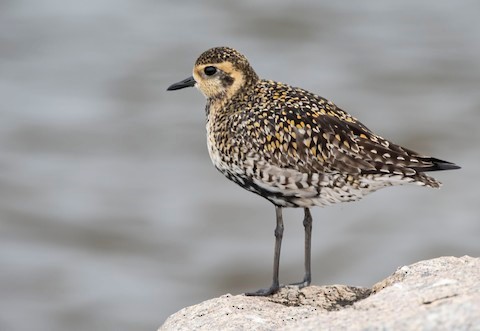
Pacific Golden-Plover, likely female molting into breeding plumage. (Clontarf, Queensland, Australia; March 20, 2021.) © Owen Lawton

Pacific Golden-Plover, molting into breeding plumage. (Clontarf, Queensland, Australia; March 20, 2021.) © Owen Lawton
Nonbreeding Plumages. Adults in nonbreeding plumage have mostly tan or buffy underparts. The upperparts are dark with yellow and white speckles.
The face usually has a broad, yellowish eyebrow and a dark ear-spot.
Immatures resemble nonbreeding adults, but typically appear buffier or yellower.
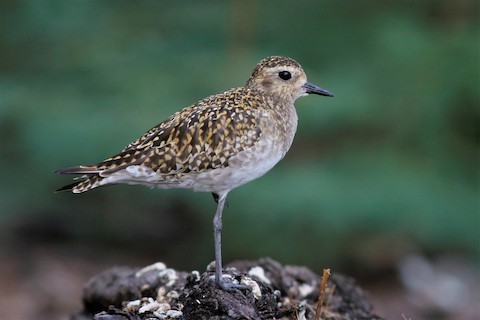
Pacific Golden-Plover in typical nonbreeding plumage. (Aimakapa Pond, Kaloko-Honokohau National Historic Park, Big Island, Hawaii; October 26, 2019.) © John Sullivan
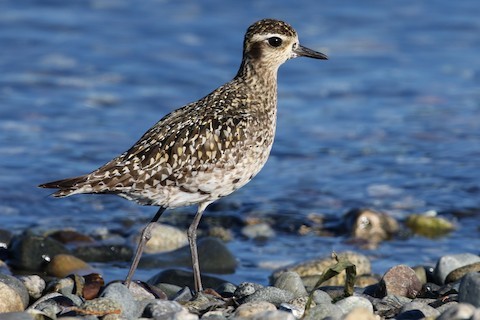
Pacific Golden-Plover in nonbreeding plumage, at the white or gray end of the spectrum (thus resembling American Golden-Plover). (Whiffin Spit Park, Sooke, British Columbia; October 16, 2018.) © Blair Dudeck
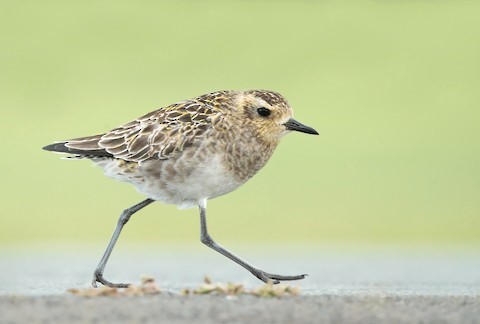
Pacific Golden-Plover in nonbreeding plumage, paler and buffier than most. (Lord Howe Island, Australia; December 14, 2020.) © David Irving
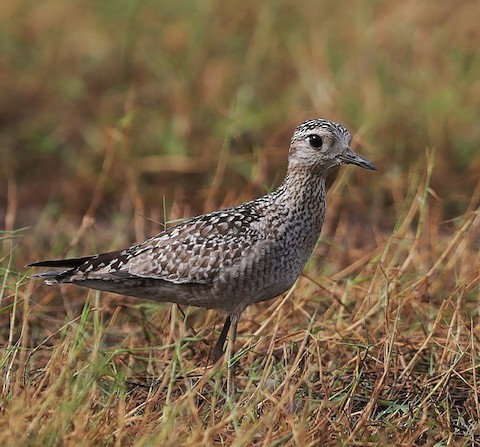
Pacific Golden-Plover, nonbreeding plumage—an unusually gray individual. (Townsville, Queensland, Australia; November 19, 2018.) © Tony Ashton
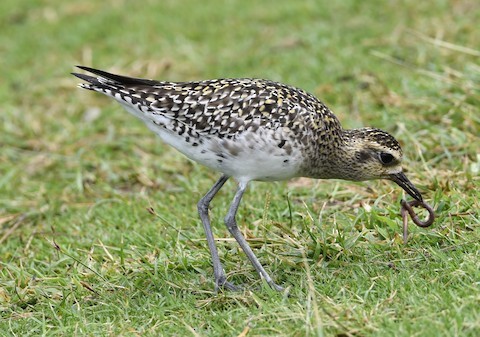
Pacific Golden-Plover, nonbreeding plumage. (Kapalua Resort, Lahaina, Maui, Hawaii; February 13, 2019.) © Katie Grigsby

Pacific Golden-Plover, beginning to molt into breeding plumage. (Koke’e State Park, Kauai, Hawaii; March 29, 2016.) © Dan Murphy
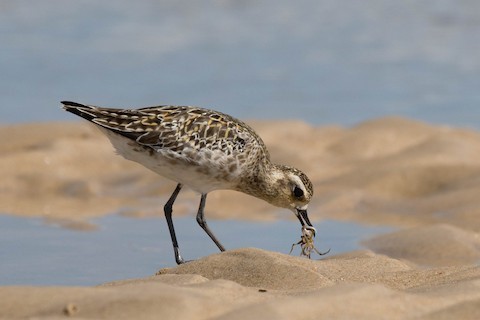
Pacific Golden-Plover, typical nonbreeding plumage. (Noosaville, Queensland, Australia; January 8, 2018.) © Terence Alexander

Pacific Golden-Plover, nonbreeding plumage. (Kurnell Harbour, Sutherland Shire, New South Wales, Australia; March 2, 2019.) © J.J. Harrison
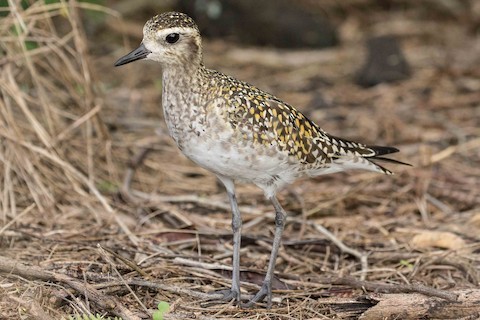
Pacific Golden-Plover, nonbreeding plumage. (Aimakapa Pond, Kaloko-Honokohau National Historic Park, Big Island, Hawaii; September 17, 2017.) © Eric VanderWerf

Pacific Golden-Plover, nonbreeding plumage—toward the yellow end of the spectrum. (Kauai Coast Resort, Wailua, Kauai, Hawaii; January 4, 2011.) © Nick Anich
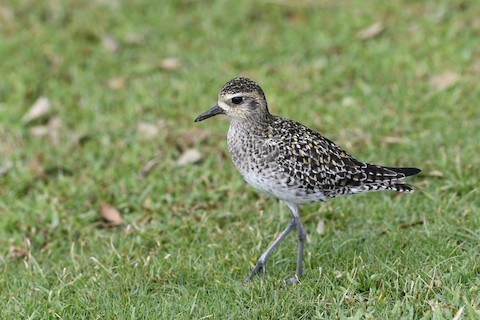
Pacific Golden-Plover, nonbreeding plumage, showing more white-and-black contrast than most. (Kapalua Resort, Lahaina, Maui, Hawaii; February 13, 2019.) © Katie Grigsby

Pacific Golden-Plover, nonbreeding plumage, showing strong contrast between pale and dark. (Wallaga Lake, New South Wales, Australia; December 10, 2018.) © Ash Allnutt
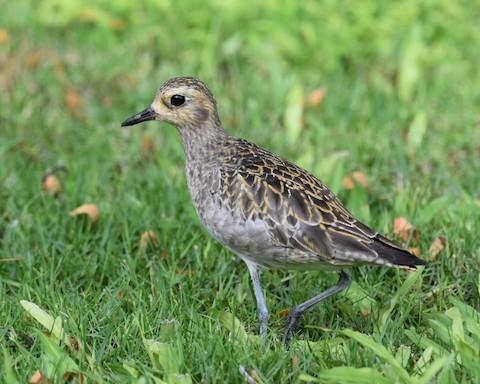
Pacific Golden-Plover, beginning to molt into breeding plumage. (Waikoloa Beach Resort, Big Island, Hawaii; March 4, 2018.) © Don Hoechlin

Pacific Golden-Plover, nonbreeding plumage—with an exceptionally buffy head. (Makaiwa Bay, Big Island, Hawaii; October 21, 2018.) © Merry Miller

Pacific Golden-Plover, typical nonbreeding plumage. (Long Valley, Hong Kong; September 26, 2014.) © Lo Chun Fai
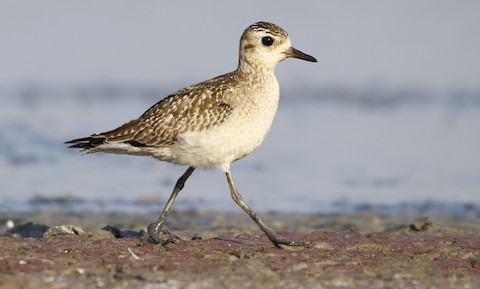
Pacific Golden-Plover, nonbreeding plumage at the pale end of the spectrum. (Bhaskarpura Wetland, Surendranagar, Gujarat, India; November 29, 2020.) © Bhaarat Vyas
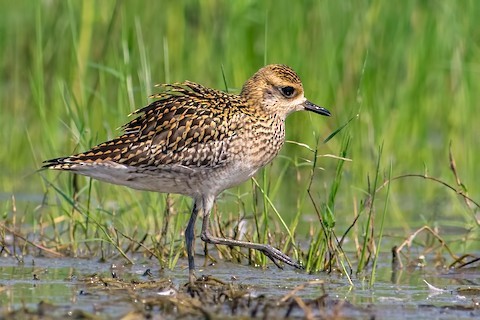
Pacific Golden-Plover, nonbreeding plumage with strongly contrasting black and buffy spots. (Kheda Jhanjhrola, Gurgaon, Haryana, India; October 3, 2020.) © Kavi Nanda
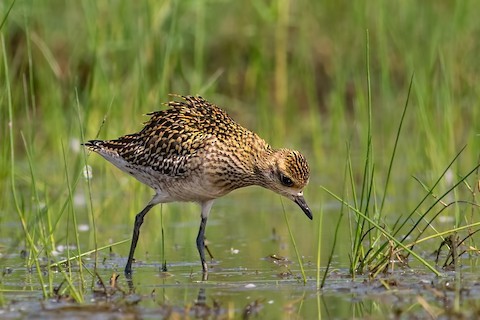
Pacific Golden-Plover, nonbreeding plumage with strongly contrasting black and buffy spots. (Kheda Jhanjhrola, Gurgaon, Haryana, India; October 3, 2020.) © Kavi Nanda

Pacific Golden-Plover, nonbreeding plumage with strongly contrasting black and buffy spots on chest. (Kheda Jhanjhrola, Gurgaon, Haryana, India; October 3, 2020.) © Kavi Nanda

Pacific Golden-Plover, nonbreeding plumage without contrasting spots on chest. (Waikoloa Beach Resort, Big Island, Hawaii; March 4, 2018.) © Don Hoechlin

Pacific Golden-Plover, nonbreeding plumage, gray overall but with strongly contrasting shades. (Tempasuk Plain, Sabah, Malaysia; November 6, 2018.) © Dave Bakewell
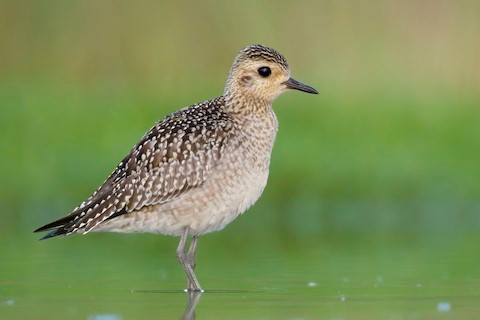
Pacific Golden-Plover, likely juvenile. (Honouliuli Unit, Pearl Harbor National Wildlife Refuge, Oahu, Hawaii; October 27, 2018.) © Sharif Uddin
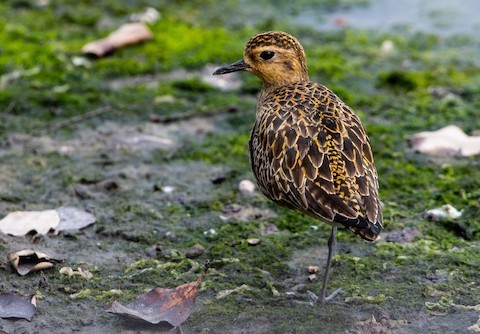
Pacific Golden-Plover, nonbreeding plumage—with maximally orange-buffy upperparts. (Linbian Qifeng, Pingtung County, Taiwan; December 4, 2020.) © Liu Jyun-Fu
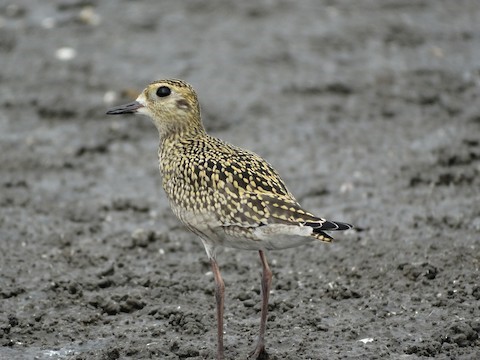
Pacific Golden-Plover, nonbreeding plumage—with bright yellow highlights on the upperparts. (Agacaim, Goa, India; September 26, 2017.) © Gauri Achari

Pacific Golden-Plover, nonbreeding plumage—with brightly contrasting yellow and white highlights on the upperparts. (Point La Haye, Newfoundland; December 7, 2016.) © Frank King
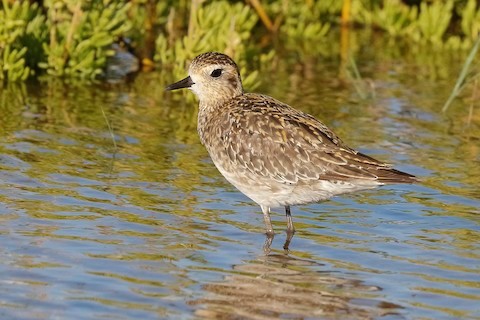
Pacific Golden-Plover, nonbreeding plumage—with mostly gray-brown upperparts. (Kealia Pond National Wildlife Refuge, Maui, Hawaii; October 15, 2017.) © Sharif Uddin

Pacific Golden-Plover, nonbreeding plumage—plain brownish overall. (Long Reef Aquatic Reserve, Collaroy, New South Wales, Australia; November 21, 2020.) © David Irving
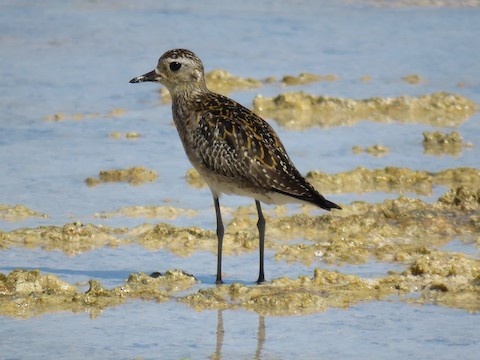
Pacific Golden-Plover, nonbreeding plumage—with mostly blackish-gray upperparts. (Rangiroa, French Polynesia; November 15, 2019.) © Ron Batie
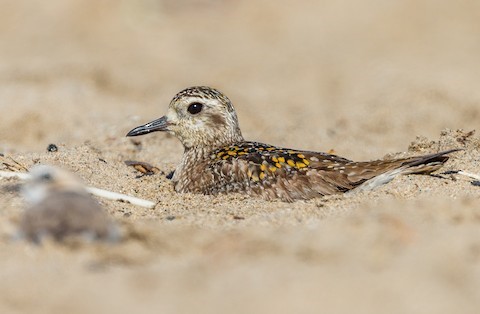
Pacific Golden-Plover, nonbreeding plumage with a few fresh yellow feathers appearing. (Dockweiler State Beach, California; February 16, 2018.) © Chezy Yusuf

Pacific Golden-Plover, nonbreeding plumage. (Waikoloa Beach Resort, Big Island, Hawaii; March 4, 2018.) © Don Hoechlin

Pacific Golden-Plover, likely juvenile. (Pico Creek, San Simeon, California; October 28, 2018.) © Tom Edell

Pacific Golden-Plover, likely juvenile. (Kuualii Fishpond, Big Island, Hawaii; October 19, 2012.) © Etienne Artigau
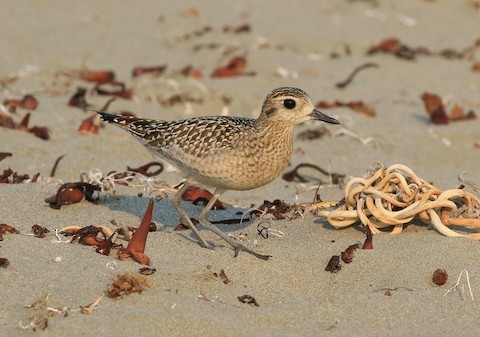
Pacific Golden-Plover, likely juvenile—buffy all over. (Estero Bluffs State Park, California; October 1, 2020.) © Roger Zachary
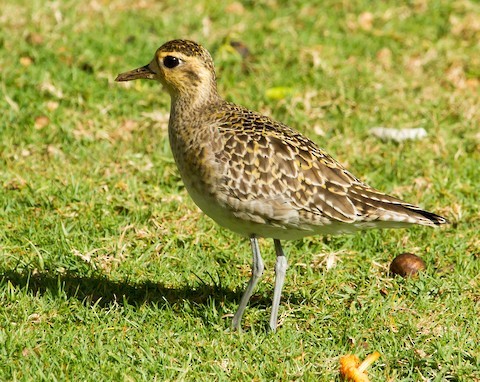
Pacific Golden-Plover, nonbreeding plumage—buffy individual. (Princeville, Kauai, Hawaii; February 15, 2016.) © Ian Burgess
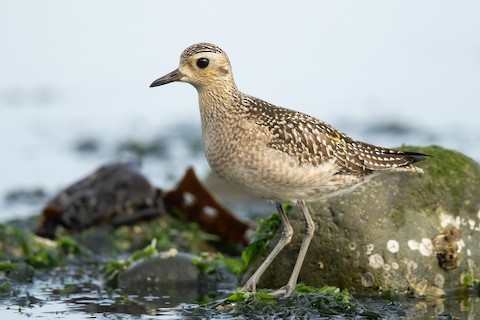
Pacific Golden-Plover, likely juvenile. (Miracle Beach Provincial Park, British Columbia; October 14, 2019.) © Ilya Povalyaev
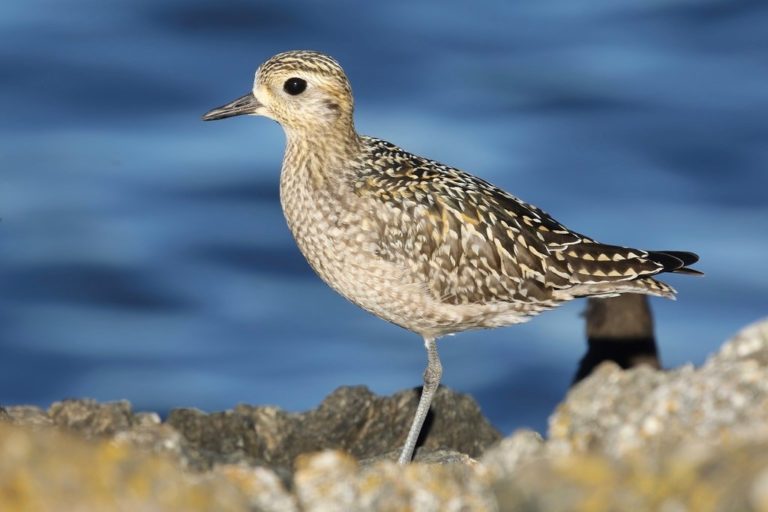
Pacific Golden-Plover, likely juvenile. (Clover Point, Victoria, British Columbia; September 2, 2020.) © Liam Singh

Pacific Golden-Plover, close view of mottled pattern. (Makiki District Park, Honolulu, Hawaii; January 23, 2021.) © Kellen Apuna
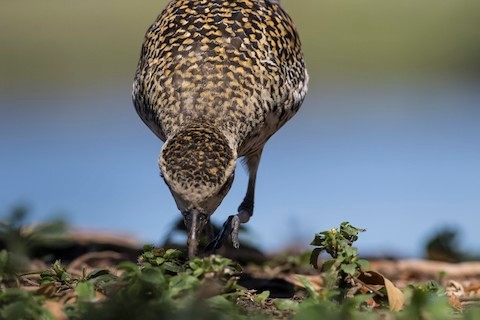
Pacific Golden-Plover, close view of mottled pattern. (Waiakea Pond, Wailoa River State Park, Big Island, Hawaii; February 26, 2019.) © Jacob Drucker
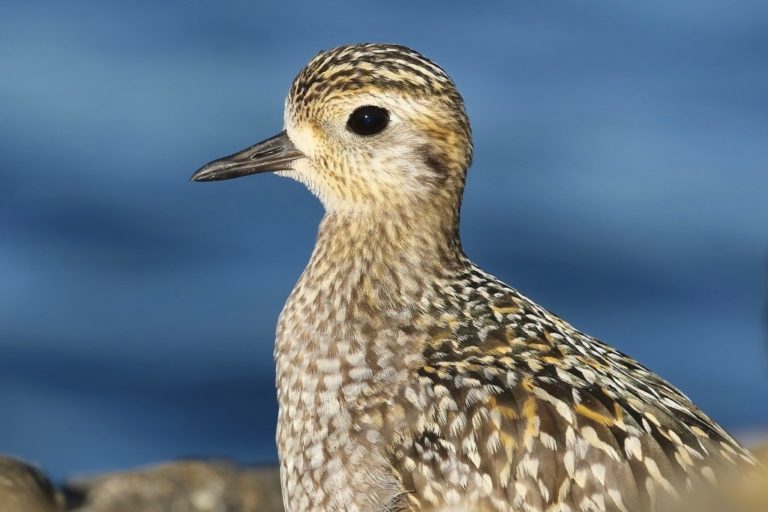
Pacific Golden-Plover, likely juvenile, close view of mottled pattern. (Clover Point, Victoria, British Columbia; September 2, 2020.) © Liam Singh
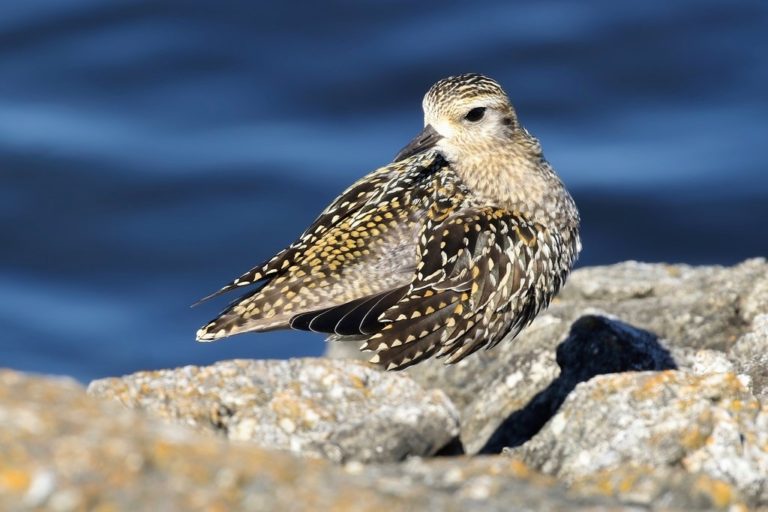
Pacific Golden-Plover, likely juvenile, close view of mottled pattern. (Clover Point, Victoria, British Columbia; September 2, 2020.) © Liam Singh

Pacific Golden-Plovers in flight. (Farquhar Inlet, Old Bar, New South Wales, Australia; January 3, 2020.) © David Irving
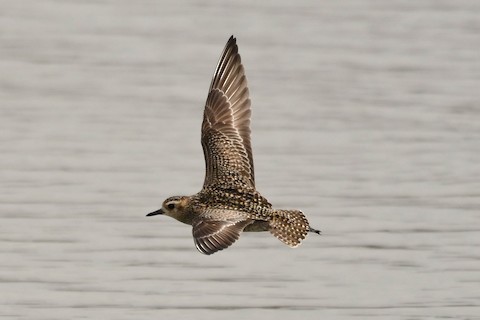
Pacific Golden-Plover in flight, dorsal view. (Port of Brisbane, Queensland, Australia; November 18, 2018.) © Wayne Schulz
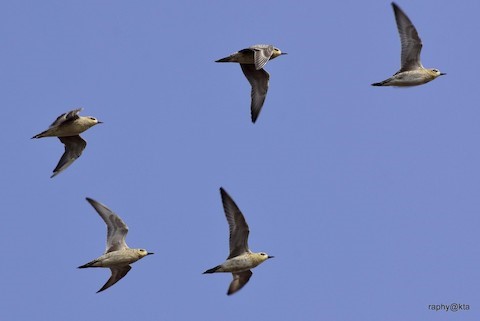
Pacific Golden-Plovers in flight, showing gray underwings. (Manakodi, Thrissur, Kerala, India; November 17, 2016.) © Raphy Kallettumkara
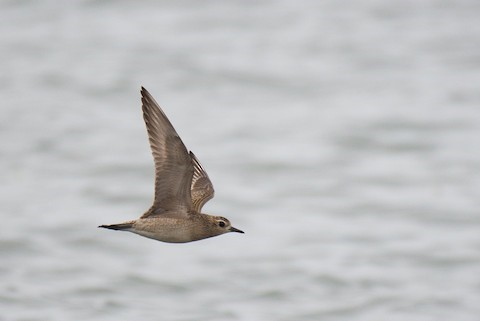
Pacific Golden-Plover in flight, showing gray underwing. (University of California – Santa Barbara, Goleta, California; October 21, 2020.) © Herb Elliott
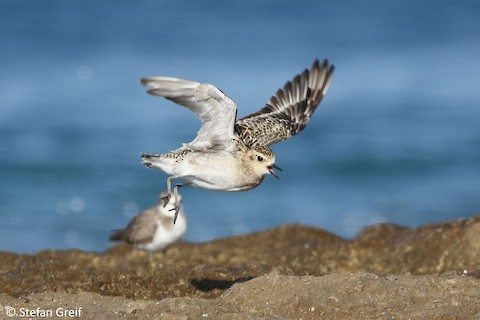
Pacific Golden-Plover in flight, with underwing appearing mostly whitish. (Tel Barukh, Tel Aviv, Israel; November 7, 2018.) © Stefan Greif

Pacific Golden-Plover with underwing appearing mostly whitish, but gray on the axillaries. (Pulau Serangan, Bali, Indonesia; October 20, 2015.) © Bruno Durand
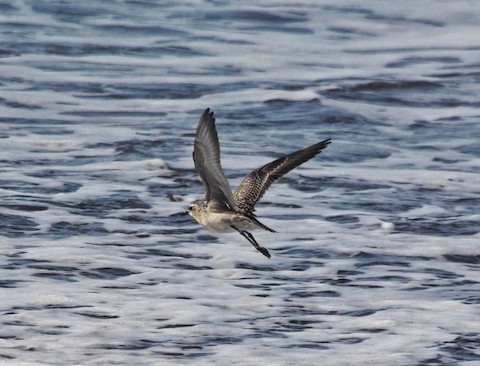
Pacific Golden-Plover in flight, showing gray underwing. (MacKerricher State Park, Cleone, California; October 26, 2017.) © Richard Hubacek
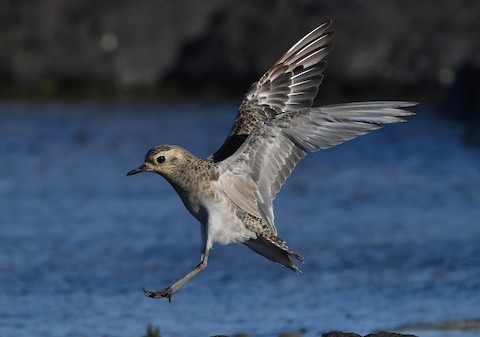
Pacific Golden-Plover in flight, showing gray underwing. (Flat Rock, Ballina, New South Wales, Australia; November 13, 2020.) © Steven McBride
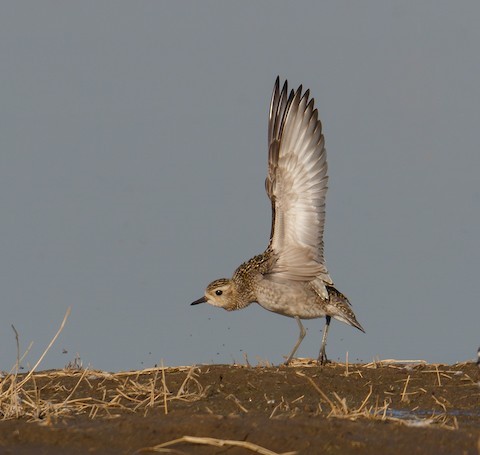
Pacific Golden-Plover with underwing appearing mostly whitish, but gray on the axillaries. (Fresno Wastewater Treatment Plant, Fresno, California; October 27, 2017.) © Gary Woods
Cf. American Golden-Plover. Pacific and American Golden-Plovers were long regarded as a single species, known collectively as the Lesser Golden-Plover. They are very similar and overlap in most visible characteristics, so many individuals are ambiguous and require a close study to distinguish—and in some cases even a close study is inconclusive.
Adults in fully or nearly fully breeding plumage can usually be identified based on the distribution of black and white on the underparts. American has wider white patches on the sides of the chest and more extensive black on the belly, extending back to the undertail coverts and showing little if any white on the sides and flanks. Conversely, Pacific has narrower white patches on the sides of the chest, wider white borders on the sides and flanks, and all or mostly white undertail coverts.
In other plumages, Pacific typically appears warmer, yellower, more “golden” overall, whereas American typically appears colder, whiter, and grayer. The difference in shading tends to be most pronounced on the face, neck, and belly. However, both species vary considerably. Some Pacifics appear far whiter or grayer than average, and some Americans appear for yellower. The tendencies are not consistent enough to be a reliable distinction.
The most consistent difference appears to be wing length, detected as the projection of the primary tips (which are uniform dark-gray) beyond the tertials (which have a noticeable pattern of pale spots). On most Americans, the primaries project about an inch or more past the tertials. On most Pacifics, the primary tips are barely visible. This distinction seems to be fundamental enough to be reliable when observed. Nevertheless, there are certain molt conditions in which each species can briefly masquerade as the other: i.e., when a Pacific’s tertials are worn, or an American’s primaries are growing in.
Other distinctions that may be helpful in some cases include facial pattern and overall structure or posture (incorporating leg and tail length). Facially, American usually shows more contrast between its pale, whitish eyebrow and dark crown, and a less pronounced ear-spot. Pacific tends to show a yellower eyebrow and larger, darker, more pronounced ear-spot. Structurally, American has a slightly longer tail and shorter legs, so its overall appearance is lower and longer, whereas Pacific has a proportionately shorter tail, longer legs, and slimmer, more vertical posture.
Cf. European Golden-Plover. European Golden-Plover closely resembles both American and Pacific Golden-Plovers. European is more heavily built, but has shorter legs and a smaller bill—although these differences are somewhat variable and can be difficult to judge.
The most consistently detectable differences are on the wings. On the underside, European has bright-white wing-linings whereas American and Pacific have medium-gray (sometimes appearing pale-gray) wing linings. On the upperside, European has a more pronounced whitish wing-stripe, broader and more contrasty than on American and Pacific.
Notes
Monotypic species.
References
Alderfer, J., and J.L. Dunn. 2014. National Geographic Complete Birds of North America (Second Edition). National Geographic Society, Washington, D.C.
BirdLife International. 2019. Pluvialis fulva (amended version of 2016 assessment). The IUCN Red List of Threatened Species 2019: e.T22693735A155529922. https://dx.doi.org/10.2305/IUCN.UK.2016-3.RLTS.T22693735A155529922.en. (Accessed April 1, 2021.)
Brazil, M. 2009. Birds of East Asia. Princeton University Press.
de la Peña, M.R., and M. Rumboll. 1998. Birds of Southern South America and Antarctica. Princeton University Press.
eBird. 2021. eBird: An online database of bird distribution and abundance. Cornell Lab of Ornithology, Ithaca, N.Y. http://www.ebird.org. (Accessed April 1, 2021.)
Garcia-del-Rey, E. 2011. Field Guide to the Birds of Macaronesia: Azores, Madeira, Canary Islands, Cape Verde. Lynx Editions, Barcelona.
Howell, S.N.G., and S. Webb. 1995. A Guide to the Birds of Mexico and Northern Central America. Oxford University Press.
Kirwan, G.M., A. Levesque, M. Oberle, and C.J. Sharpe. 2019. Birds of the West Indies. Lynx Edicions, Barcelona.
Marchant, J., T. Prater, and P. Hayman. 1986. Shorebirds: An Identification Guide to the Waders of the World. Houghton Mifflin, Boston.
Mullarney, K., L. Svensson, D. Zetterström, and P.J. Grant. 1999. Birds of Europe. Princeton University Press.
Pyle, R.L., and P. Pyle. 2017. The Birds of the Hawaiian Islands: Occurrence, History, Distribution, and Status. Version 2 (January 1, 2017). http://hbs.bishopmuseum.org/birds/rlp-monograph/. B.P. Bishop Museum, Honolulu, Hawaii.
Ridgely, R.S., and P.J. Greenfield. 2001. The Birds of Ecuador, Volume II: Field Guide. Cornell University Press.
Schulenberg, T.S., D.F. Stotz, D.F. Lane, J.P. O’Neill, and T.A. Parker. 2007. Birds of Peru. Princeton University Press.
Sibley, D.A. 2000. The Sibley Guide to Birds. Alfred A. Knopf. New York.
Sinclair, I., P. Hockey, W. Tarboton, and P. Ryan. 2011. Birds of Southern Africa (Fourth Edition). Random House Struik (Pty) Ltd. Cape Town, South Africa.
Xeno-Canto. 2021. Pacific Golden Plover – Pluvialis fulva. https://www.xeno-canto.org/species/Pluvialis-fulva. (Accessed April 1, 2021.)


